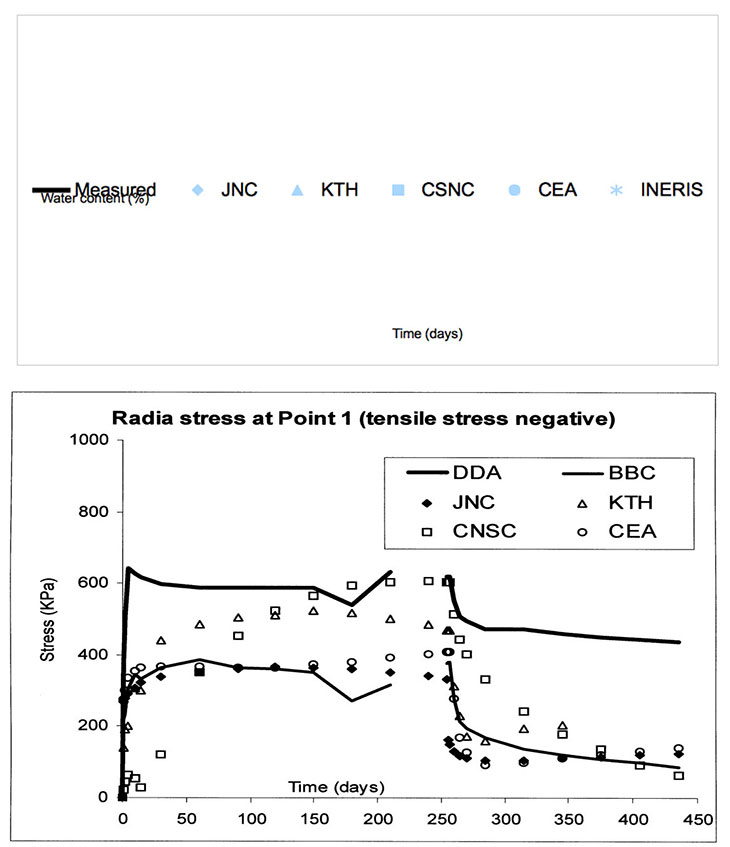BMT1was aimed at scoping calculations to estimate the influence of T-H-M processes on the flow pattern, as well as the structural integrity of the geological and engineered barriers in the near-field of a typical repository. The technical definition was based on a conceptual design of a hypothetical nuclear waste repository in a granitic rock used in the Kamaishi THM experiment in Japan (Fig. 4.3a), but the rock mass properties in term of strength and permeability were based on typical Canadian Shield data. The objective was to study impacts of issues of significance to the Performance Assessments of repositories, including temperature evolution in the near-field, buffer re-saturation time, stress states in buffer and canisters, permeability and water flow in the near-field, rock failure, and uncertainties and rock property variability. BMT1 was divided into 3 steps: Step 1 (subtask BMT1A), Step 2 (subtask BMT1B) and Step 3 (subtask BMT1C).
The objective of Step 1(subtask BMT1A) was to validate and calibrate the numerical approaches, computer codes and material models, against realistic rock mass conditions and measured data from reference T-H-M experiments for thermal, hydraulic and mechanical variables. The reference experiment chosen for BMT1 was the Kamaishi in-situ experiment at Kamaishi Mine, Japan, performed in the 550 m-Level gallery of the experimental site, as illustrated in Fig.5a.
The aim of Step 2 (subtask BMT1B) was to identify the coupling mechanisms of importance for construction, performance and safety of the repository by scoping calculations, considering varying degrees of THM coupling, for the generic repository design shown in Fig. 5a. To simplify the calculation process and focus on the physics of the problems instead of computational efforts, the geometry of the problem, especially regarding the geometry of the fractures, was greatly simplified to regular fracture geometries. The rock was considered to be homogeneous without any explicitly represented fractures. However, different permeability values were considered.
The aim of Step 3 (subtask BMT1C) was to perform scoping calculations with different coupling combinations based on the same conceptual repository design but with the addition of one horizontal fracture intersecting the deposition hole and one vertical fracture zone dividing the two adjacent deposition tunnel/hole system in order to evaluate the impact of fracture flow on the variables of importance for Performance Assessment. Another model of highly fractured rock mass with two orthogonal sets of fractures was also studied by one team. It was identified that the output results had a strong influence on: the long term safety and performance of the repository: the maximal temperature created by the thermal loading from the emplaced wastes; the time for re-saturation of the buffer; the maximal swelling stress developed in the buffer; the structural integrity of the rock mass; and the permeability evolution in the rock mass.

The funding organizations and their research teams for BMT1 of Task 3 can be seen in Table 1.
A number of improvements to the modelling of the Kamaishi Mine heater test were suggested and tested in this study. The suggested improvements were tested using a simplified axisymmetric model of the heater test (Fig. 5b). Although the model geometry is much simplified compared to the field test conditions, improved simulation of the general THM responses were obtained, as compared with the Task 2C results of DECOVAEX II. The measures taken for improvement by different teams were parameter calibrations, inclusion of the sealing of rock fractures by penetrating bentonite to explain the uniform (axisymmetric) wetting of the bentonite, improving the swelling/shrinking strain function combined with an increased thermal expansion of the bentonite, and using a “sealed” layer of rock around the bentonite (by the CNSC team). As a consequence of the above measures, the results from the simplified axisymmetric model used in the re-evaluation of the Kamaishi mine experiment showed general improvement over the original models used in the prediction phase during the DECOVALEX II project, especially in the following aspects: temperature, stress and strain behaviour in the bentonite, and water content near the heater (at point 1).
In general, the mechanical behaviour of the buffer is complex with forces affected by shrinking/swelling in all part of the bentonite, external stress from the thermal expansion of the heater and rock, and internal thermal expansion of the bentonite itself. However, a reasonable prediction of the mechanical behaviour can be achieved if all relevant bentonite properties are known from laboratory tests.

Besides the three reports generated for BMT1a, BMT1B and BMT1C of Task 3, three journal papers were also published in a special issue of the International Journal of Rock Mechanics and Mining Sciences, Volume 42, Number 5-6, in 2005